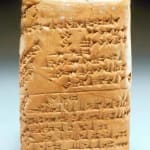Middle Babylonian Terracotta Cuneiform Tablet, 1308 BCE - 1282 BCE
Terracotta
2.5 x 4
X.0126
The oldest known written language, cuneiform, first used by the ancient peoples of the Near East over 5000 years ago, is composed of a series of wedge-shaped incisions made with...
The oldest known written language, cuneiform, first used by the ancient peoples of the Near East over 5000 years ago, is composed of a series of wedge-shaped incisions made with a sharpened reed stylus. This script was adopted by all the major civilizations of Mesopotamia for recording their distinct languages, including the Sumerians, Akkadians, Assyrians, and Babylonians. Clay tablets were the preferred media for everyday writing because they could either be easily recycled or, if a permanent record was required, fired in a kiln and preserved. The earliest recorded inscriptions are not myths of histories, but rather banal economic transactions and accounting documents. Later, one of the most famous written works of the ancient world, Hammurabi’s code, was recorded in the cuneiform script. While these marks may appear obscure and mysterious to our eyes, scholars have made much progress in deciphering cuneiform after discovering inscriptions on the Behistun Rock, a cliff in western Iran. Much like the Rosetta Stone, the Behistun Inscription contained the same text written in three different languages (Persian, Babylonian, and Elamite), all of which utilized the cuneiform system of writing. Due to the resemblance of these languages to modern ones, scholars were able to crack to code.
This terracotta tablet reveals just how intricate a system of writing cuneiform was. In the hands of a talented scribe, a remarkable amount of information could be squeezed into a relatively small space and yet still remain legible. Both the front and back of this tablet have been written on, containing a total of thirty-four lines of text. Like most tablets that survive, the text details administrative matters, here relating to an endowment, including the names of those making the endowment among other information. Dated to the reign of Nazi-Maruttash, the Kassite King of Babylon, this fascinating tablet may have been little more than an invoice or contract during its own time. However, today, this work provides valuable insight into the domestic affairs of the Middle Babylonians while also serving as an astounding example of how refined the cuneiform script was.
This terracotta tablet reveals just how intricate a system of writing cuneiform was. In the hands of a talented scribe, a remarkable amount of information could be squeezed into a relatively small space and yet still remain legible. Both the front and back of this tablet have been written on, containing a total of thirty-four lines of text. Like most tablets that survive, the text details administrative matters, here relating to an endowment, including the names of those making the endowment among other information. Dated to the reign of Nazi-Maruttash, the Kassite King of Babylon, this fascinating tablet may have been little more than an invoice or contract during its own time. However, today, this work provides valuable insight into the domestic affairs of the Middle Babylonians while also serving as an astounding example of how refined the cuneiform script was.



